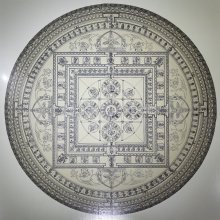Upayaparamita, Upāyapāramitā, Upaya-paramita: 3 definitions
Introduction:
Upayaparamita means something in Buddhism, Pali. If you want to know the exact meaning, history, etymology or English translation of this term then check out the descriptions on this page. Add your comment or reference to a book if you want to contribute to this summary article.
Images (photo gallery)
In Buddhism
Tibetan Buddhism (Vajrayana or tantric Buddhism)
Source: archive.org: The Indian Buddhist IconographyUpāyapāramitā (उपायपारमिता) refers to one of twelve Pāramitā Goddesses in human form, as commonly depicted in Buddhist Iconography, and mentioned in the 11th-century Niṣpannayogāvalī of Mahāpaṇḍita Abhayākara.—Her Colour is green; her Symbol is a vajra on lotus; she has two arms.
Upāyapāramitā is described in the Niṣpannayogāvalī (dharmadhātuvāgīśvara-maṇḍala) as follows:—
“Upāyapāramitā is green like the priyaṅgu flower and holds in her left hand the vajra on a yellow lotus”.
[The right hand carries the cintāmaṇi banner as usual. Her statue is found in China.
The twelve deities collectively have their spiritual father in Ratnasambhava. [...] According to a statement in the maṇḍala all the deities [viz., Upāyapāramitā] are two-armed, and they hold in the right hand the flag marked with the Cintāmaṇi jewel, and in the left their special symbols. Prajñāpāramitā is an exception since she has two more hands.]

Tibetan Buddhism includes schools such as Nyingma, Kadampa, Kagyu and Gelug. Their primary canon of literature is divided in two broad categories: The Kangyur, which consists of Buddha’s words, and the Tengyur, which includes commentaries from various sources. Esotericism and tantra techniques (vajrayāna) are collected indepently.
Mahayana (major branch of Buddhism)
Source: academia.edu: A Study and Translation of the GaganagañjaparipṛcchāUpāyapāramitā (उपायपारमिता) refers to the “perfection of skillful means”, according to the Gaganagañjaparipṛcchā: the eighth chapter of the Mahāsaṃnipāta (a collection of Mahāyāna Buddhist Sūtras).—Accordingly: “[...] Since this Bodhisattva Gaganagañja paid homage and respect to the Awakened Lords as numerous as the grains of sand in the river Gaṅgā, Śāriputra, his thought of awakening was purified; [...] by purifying the perfection of insight as numerous as the grains of sand in the river Gaṅgā, the perfection of skillful means (upāyapāramitā) was purified; by purifying the perfection of insight as numerous as the grains of sand in the river Gaṅgā, the unhindered thoughts and unobstructed rays of light to all beings were purified; [...]”.

Mahayana (महायान, mahāyāna) is a major branch of Buddhism focusing on the path of a Bodhisattva (spiritual aspirants/ enlightened beings). Extant literature is vast and primarely composed in the Sanskrit language. There are many sūtras of which some of the earliest are the various Prajñāpāramitā sūtras.
General definition (in Buddhism)
Source: Wisdom Library: Dharma-samgrahaUpāyapāramitā (उपायपारमिता) or simply upāya refers to the “perfection of skilful means” and represents the seventh of the “ten perferctions” (daśapāramitā) as defined in the Dharma-saṃgraha (section 18). The Dharma-samgraha (Dharmasangraha) is an extensive glossary of Buddhist technical terms in Sanskrit (e.g., daśa-pāramitā and upāya-pāramitā). The work is attributed to Nagarjuna who lived around the 2nd century A.D.
See also (Relevant definitions)
Partial matches: Upaya, Paramita.
Full-text: Dashaparamita, Ten Perfections, Upaya.
Relevant text
Search found 1 books and stories containing Upayaparamita, Upāyapāramitā, Upaya-paramita, Upāya-pāramitā; (plurals include: Upayaparamitas, Upāyapāramitās, paramitas, pāramitās). You can also click to the full overview containing English textual excerpts. Below are direct links for the most relevant articles:
A Dictionary Of Chinese Buddhist Terms (by William Edward Soothill)
